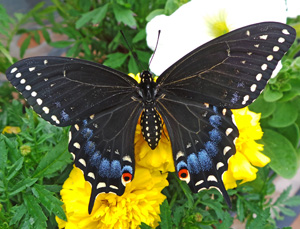The husky is reminiscent of the pet in Wisconsin who seemed to detect ovarian cancer with its sense of smell. The monarch's poisons, cardiac glycosides, are indeed for its protection as Larsen's webpage says.
(Nov 2018) Danaus plexippus Parasite Resistance / Cardiac Glycosides
The Effects of Milkweed Induced Defense on Parasite Resistance in Monarch Butterflies, Danaus plexippus. - PubMed - NCBI
The monarch is also an anticancer butterfly.
(Mar 2019) Anticancer Cardiac Glycoside Cerberin
Cardiac glycoside Cerberin exerts anticancer activity through PI3K/AKT/mTOR signal transduction inhibition. - PubMed - NCBI
The Bordered Patch does not seem to be armed with cardiac glycosides, though a glycoside does occur in its host genus, Verbesina.
(Jan 2009) Verbesinosides A-F from Verbesina
Verbesinosides A-F, 15,27-cyclooleanane saponins from the American native plant Verbesina virginica. - PubMed - NCBI
(Nov 2018) Danaus plexippus Parasite Resistance / Cardiac Glycosides
The Effects of Milkweed Induced Defense on Parasite Resistance in Monarch Butterflies, Danaus plexippus. - PubMed - NCBI
The monarch is also an anticancer butterfly.
(Mar 2019) Anticancer Cardiac Glycoside Cerberin
Cardiac glycoside Cerberin exerts anticancer activity through PI3K/AKT/mTOR signal transduction inhibition. - PubMed - NCBI
The Bordered Patch does not seem to be armed with cardiac glycosides, though a glycoside does occur in its host genus, Verbesina.
(Jan 2009) Verbesinosides A-F from Verbesina
Verbesinosides A-F, 15,27-cyclooleanane saponins from the American native plant Verbesina virginica. - PubMed - NCBI


